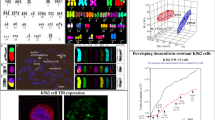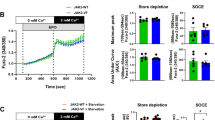Abstract
Apoptosis, or programmed cell death, is a very important phenomenon in cytotoxicity induced by anticancer treatment. 1α,25-Dihydroxyvitamin D3 (1,25-(OH)2D3), the active metabolite of vitamin D, inhibits the growth of multiple types of cancer cells including breast, colon, and prostate cancer cell lines. We studied alterations in the mRNA expression levels of BCL2, BAX, CYC, BCL-XL, and VDR genes in the K562 chronic myeloid leukemia cell line in response to treatment with 1,25-(OH)2D3. Morphological observation of K562 cells was evaluated by the staining with Wright's solution. Cell percentage at different phases of the cell cycle was measured, and apoptosis was measured by flow cytometry. The expression levels of the apoptosis-related genes were analyzed by real-time reverse transcription polymerase chain reaction. We found that treatment with 1,25-(OH)2D3 down-regulates BCL2 and BCL-XL mRNA expressions, as well as up-regulates expressions of BAX and p21 mRNA. The expression pattern of CYC and VDR genes were not influenced. However, K562 cells treated with 1,25-(OH)2D3 caused an arrest of cell cycle progression in G1 phase resulting in a decreased number of cells in the S phase, complemented by an accumulation of cells in the G0–G1 phases. Our data show the modulatory effects of 1,25-(OH)2D3 treatment in apoptosis-related genes in K562 cells.




Similar content being viewed by others
References
Colston KW, Colston MJ, Feldman D (1981) 1, 25-Dihydroxyvitamin D3 and malignant melanoma: the presence of receptors and inhibition of cell growth in culture. Endocrinology 108:1083–1086
Abe E, Miyaura C, Sakgami H et al (1981) Differentiation of mouse myeloid leukemia cells induced by 1a, 25-dihydroxyvitamin D3. Proc Natl Acad Sci U S A 78:4990–4994. doi:10.1073/pnas.78.8.4990
Elstner E, Linker-Israeli M, Umiel T et al (1995) Combination of a potent 20-epi-vitamin D3 analog (KH 1060) with 9-cis-retinoic acid irreversibly inhibits clonal growth, decreases bcl-2 expression, and induces apoptosis in HL-60 leukemic cells. Cancer Res 56:3570–3576
Colston KW, Chander SK, Mackay AG, Coombes RC (1992) Effects of synthetic vitamin D analogs of breast cancer cell proliferation in vivo and in vitro. Biochem Pharmacol 44:693–702. doi:10.1016/0006-2952(92)90405-8
Vandewalle B, Hornez L, Wattez N, Revillion F, Lefebvre J (1995) Vitamin-D3 derivatives and breast-tumor cell growth: effect on intracellular calcium and apoptosis. Int J Cancer 61:806–811. doi:10.1002/ijc.2910610611
Colston KW, Mackay AG, James SY, Binderup L (1992) EB1089, a new vitamin D analog that inhibits the growth of breast cancer cells in vivo and in vitro. Biochem Pharmacol 44:2273–2280. doi:10.1016/0006-2952(92)90669-A
Schwartz GG, Hill CC, Oeler TA, Becich MJ, Bahnson RR (1995) 1, 25-Dihydroxy-16–23-yne-vitamin D3 and prostate cancer cell proliferation in vivo. Urology 46:365–369. doi:10.1016/S0090-4295(99)80221-0
Chen TC, Schwartz GG, Burnstein KL, Lokeshwar BL, Holick MF (2000) The in vitro evaluation of 25-hydroxyvitamin D3 and 19-nor-1, 25-dihydroxyvitamin D2 as therapeutics agents for prostate cancer. Clin Cancer Res 6:901–908
Skarosi S, Abraham C, Bissonette M, Scaglione-Sewel B, Siltrin MD, Brastius TA (1997) 1, 25-Dihydroxyvitamin D3 stimulates apoptosis in CaCo-2 cells. Gastroenterology 112:A608
Saulenas AM, Cohen SM, Key LL, Winter C, Albert DM (1988) Vitamin D and retinoblastoma: the presence of receptors and inhibition of growth in vitro. Arch Ophthalmol 106:533–535. doi:10.1016/0002-9394(88)90581-8
Haussler MR, Whitfield GK, Haussler CA et al (1998) The nuclear vitamin D receptor: biological and molecular regulatory properties revealed. J Bone Miner Res 13:325–349. doi:10.1359/jbmr.1998.13.3.325
Issa LL, Leong GM, Eisman JA (1998) Molecular mechanism of vitamin D receptor action. Inflamm Res 47:451–475. doi:10.1007/s000110050360
Wu G, Fan RS, Li W, Ko T, Brattain MG (1997) Modulation of cell cycle control by vitamin D3 and its analog, EB1089, in human breast cancer cells. Oncogene 15:1555–1563. doi:10.1038/sj.onc.1201329
Seol JG, Park WH, Kim ES et al (2000) Effect of a novel vitamin D3 analog, EB1089 on G1 cell cycle regulatory proteins in HL-60 cells. Int J Oncol 16:315–320
Liu M, Lee M-H, Cohen M, Bommakanti M, Freedman LP (1996) Transcriptional activation of the cdk inhibitor p21 by vitamin D3 leads to the induced differentiation of the myelocytic cell line U937. Genes Dev 10:142–153. doi:10.1101/gad.10.2.142
Jensen SS, Madsen MW, Lukas J, Binderup L, Bartek J (2001) Inhibitory effects of dihydroxyvitamin D3 on G1-S phase controlling machinery. Mol Endocrinol 15:1370–1380. doi:10.1210/me.15.8.1370
Reitsma PH, Rothberg PG, Astrin SM, Trial J, Bar-Shavit Z, Hall A, Teitelbaum SL, Kahn AJ (1983) Regulation of myc gene expression in HL-60 leukaemia cells by a vitamin D metabolite. Nature 306:492–494. doi:10.1038/306492a0
Kasten MM, Giordano A (1998) pRb and the cdks in apoptosis and the cell cycle. Cell Death Differ 5:132–140. doi:10.1038/sj.cdd.4400323
Mørk Hansen C, Hamberg KJ, Binderup E, Binderup L (2000) Seocalcitol (EB 1089): a vitamin D analogue of anti-cancer potential. Background, design, synthesis, pre-clinical and clinical evaluation. Current Pharmaceutical Design 6:881–906
van den Bemd GJCM, Pols HAP, van Leeuwen JPTM (2000) Anti-tumor effects of 1, 25-dihydroxyvitamin D3 and vitamin D analogs. Curr Pharm Des 6:717–732. doi:10.2174/1381612003400498
Feldman D, Zhao X-Y, Krishnan AV (2000) Vitamin D and prostate cancer. Endocrinology 141:5–9. doi:10.1210/en.141.1.5
Lozzio BB, Lozzio CB (1977) Properties of the K562 cell line derived from a patient with chronic myeloid leukemia. Int J Cancer 19:136–143. doi:10.1002/ijc.2910190119
Moore DC, Carter DL, Bhandal AK, Studzinski GP (1991) Inhibition by 1, 25 dihydroxyvitamin D3 of chemically induced erythroid differentiation of K562 leukemia cells. Blood 77:1452–1461
Naveilhan P, Berger F, Haddad K et al (1994) Induction of glioma cell death by 1, 25(OH) 2 vitamin D3: towards an endocrine therapy of brain tumors. J Neurosci Res 37:271–277. doi:10.1002/jnr.490370212
Diaz GD, Paraskeva C, Thomas MG, Binderup L, Hague A (2000) Apoptosis is induced by the active metabolite of vitamin D3 and its analog EB1089 in colorectal adenoma and carcinoma cells: possible implications for prevention and therapy. Cancer Res 60:2304–2312
Mathiasen IS, Lademann U, Jaattela M (1999) Apoptosis induced by vitamin D compounds in breast cancer is inhibited by Bcl-2 but doesn't involve known caspases or p53. Cancer Res 59:4848–4856
Miller GJ, Stapleton GE, Ferrara JA, Lucia MS, Pfister S et al (1992) The human prostatic carcinoma cell line LNCaP expresses biologically active, specific receptors for 1 alpha, 25-dihydroxyvitamin D3. Cancer Res 52:515–520
Mork-Hansen C, Frandsen TL, Brunner N, Binderup L (1994) 1α-25-Dihydroxyvitamin D3 inhibits the invasive potential of human breast cancer cells in vitro. Clin. Exp. Metas. 12:195–202. doi:10.1007/BF01753887
Colston KW, Hansen C (2002) Mechanisms implicated in the growth regulatory effects of vitamin D in breast cancer. Endocr Relat Cancer 9:45–59. doi:10.1677/erc.0.0090045
Chen S, Xue Y, Zhang X, Wu Y, Pan J, Wang Y, Ceng J (2005) A new human acute monocytic leukemia cell line SHI-1 with t(6;11)(q27;q23) gene alteration and high tumorigenicity in nude mice. Hematologia 90:766–775
Park WH, Seol JG, Kim ES, Jung CW, Lee CC, Binderup L, Koeffler HP, Kim BK, Lee YY (2000) Cell cycle arrest induced by vitamin D3 analog EB1089 in NCI-H929 myeloma cells is associated with induction of the cyclin-dependent kinase inhibitor p27. Exp Cell Res 254:279–286. doi:10.1006/excr.1999.4735
Zhang F, Rathod B, Jones JB, Wang QM, Bernhard E, Godyn JJ, Studzinski GP (1996) Increased stringency of the 1, 25-dihydroxyvitamin D3-induced G1 to S phase block in polyploid HL60 cells. J Cell Physiol 168:18–25. doi:10.1002/(SICI)1097-4652(199607)168:1<18::AID-JCP3>3.0.CO;2-B
Zhang F, Godyn JJ, Uskokovic M, Binderup L, Studzinski GP (1994) Monocytic differentiation of HL60 cells induced by potent analogs of vitamin D3 precedes the G1/G0 phase cell cycle block. Cell Prolif 27:643–654. doi:10.1111/j.1365-2184.1994.tb01379.x
Pirianov G, Colston KW (2001) Interaction of vitamin D analogs with signaling pathways leading to active cell death in breast cancer cells. Steroids 66:309–318. doi:10.1016/S0039-128X(00)00201-4
Narvaez CJ, Welsh J (2001) Role of mitochondria and caspases in vitamin D-mediated apoptosis of MCF-7 breast cancer cells. J Biol Chem 276:9101–9107. doi:10.1074/jbc.M006876200
Park WH, Seol JG, Kim ES, Hyun JM, Jung CW, Lee CC, Binderup L, Koeffler HP, Kim BK, Lee YY (2000) Induction of apoptosis by vitamin D3 analogue EB 1089 in NCI-H929 myeloma cells via activation of caspase and MAP kinase. Br J Haematol 109:576–583. doi:10.1046/j.1365-2141.2000.02046.x
Blutt SE, McDonnell TJ, Polek TC, Weigel NL (2000) Calcitriol-induced apoptosis in LNCaP cells is blocked by overexpression of Bcl-2. Endocrinology 141:10–17. doi:10.1210/en.141.1.10
Yang JY, Liu X, Bhalla K, Naekyung Kim C, Ibrado AM, Cai J, Peng T-I, Jones DP, Wang X (1997) Prevention of apoptosis by Bcl-2: release of cytochrome c from mitochondrial blocked. Science 275:1129–1132. doi:10.1126/science.275.5303.1129
Acknowledgments
We would like to thank Ozkan Bagci for his assistance in statistical analyses.
Author information
Authors and Affiliations
Corresponding author
Rights and permissions
About this article
Cite this article
Kizildag, S., Ates, H. & Kizildag, S. Treatment of K562 cells with 1,25-dihydroxyvitamin D3 induces distinct alterations in the expression of apoptosis-related genes BCL2, BAX, BCLXL, and p21. Ann Hematol 89, 1–7 (2010). https://doi.org/10.1007/s00277-009-0766-y
Received:
Accepted:
Published:
Issue Date:
DOI: https://doi.org/10.1007/s00277-009-0766-y




